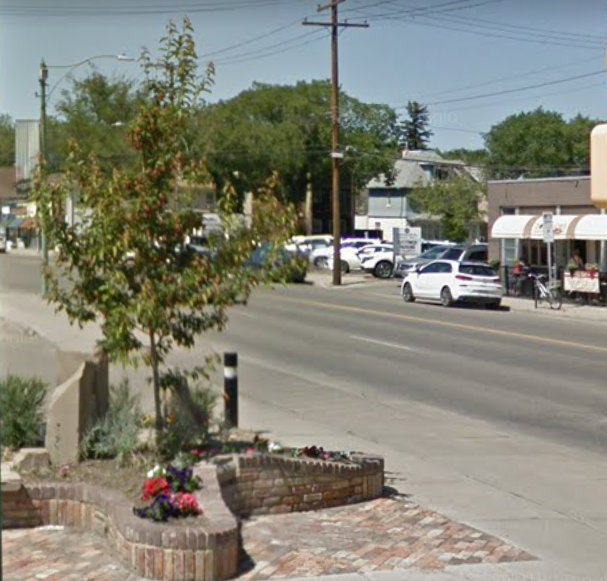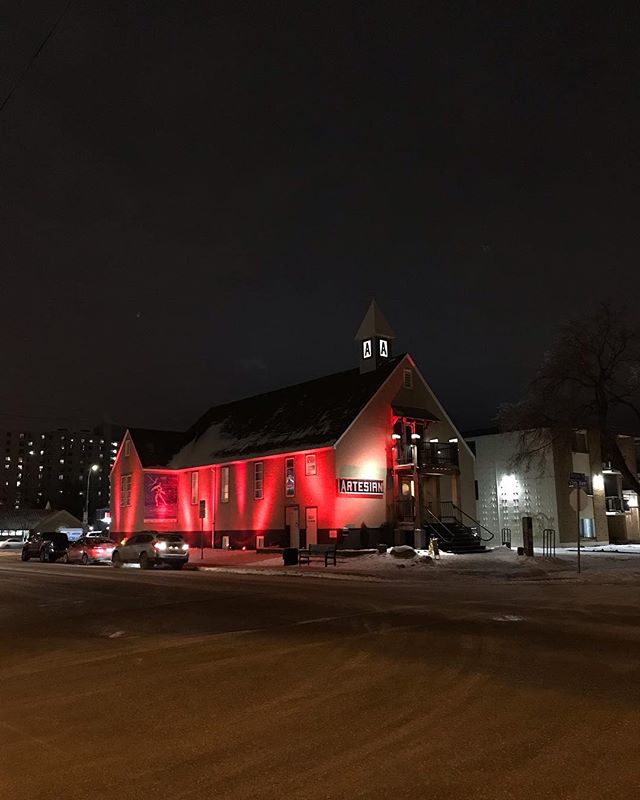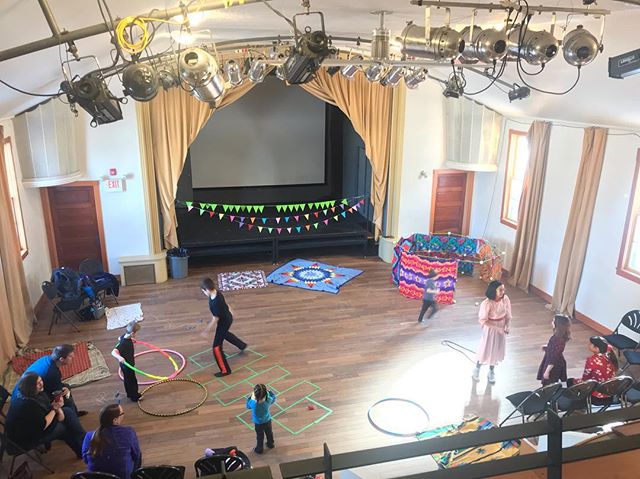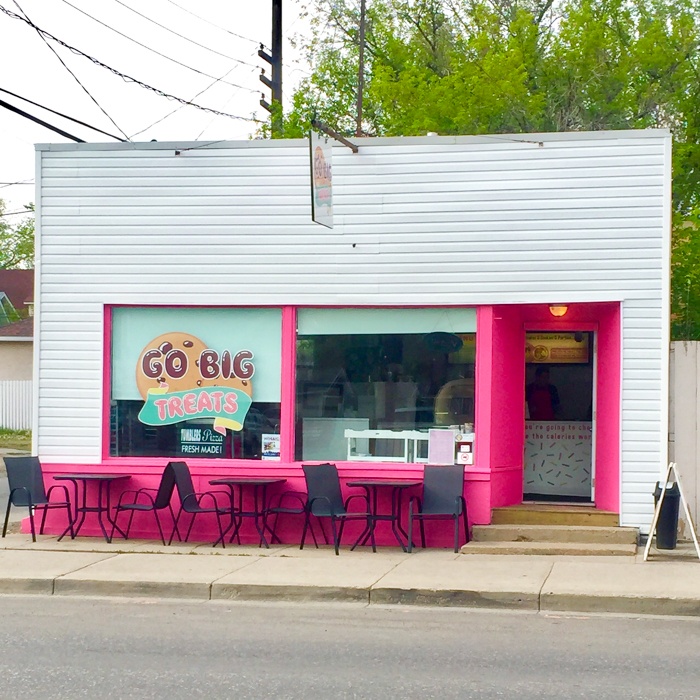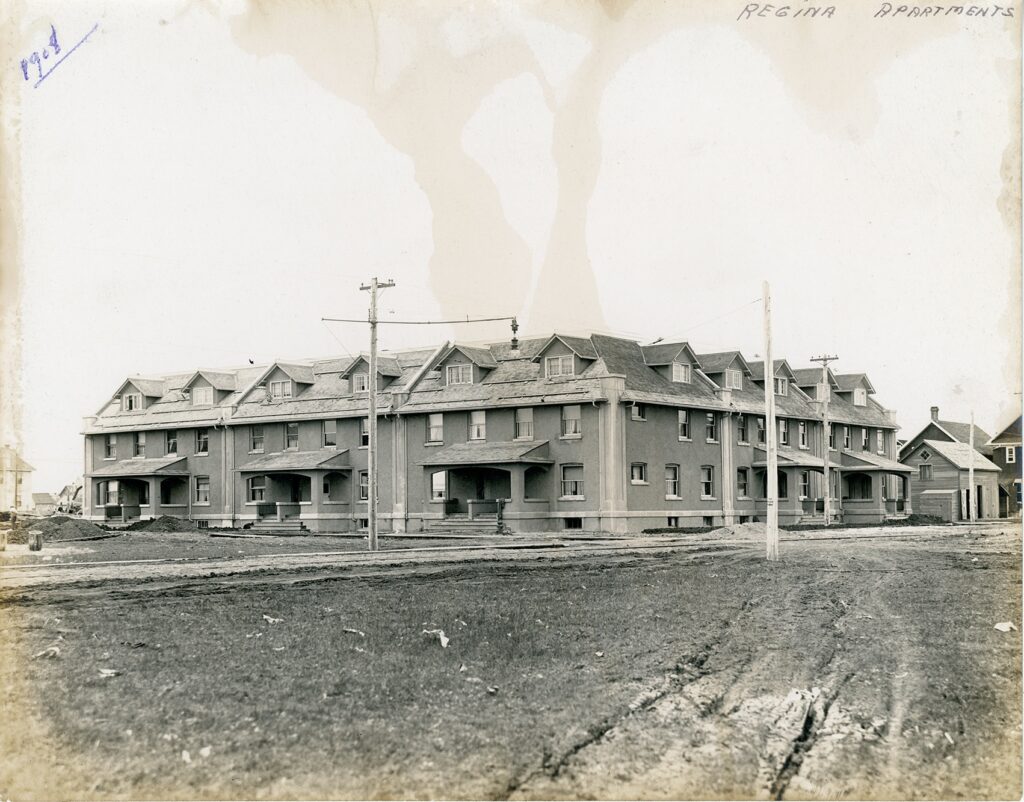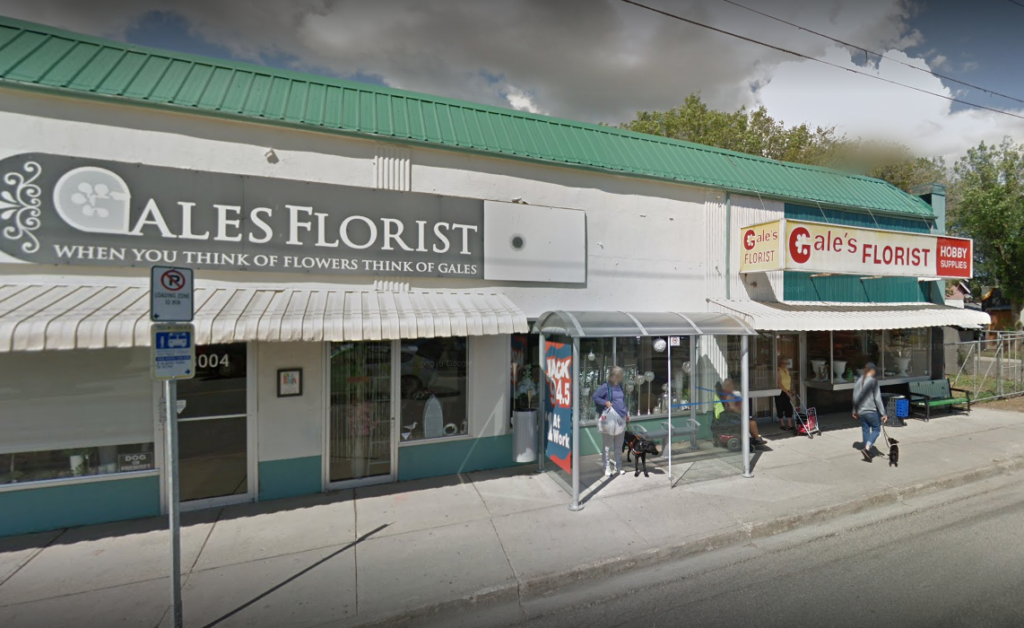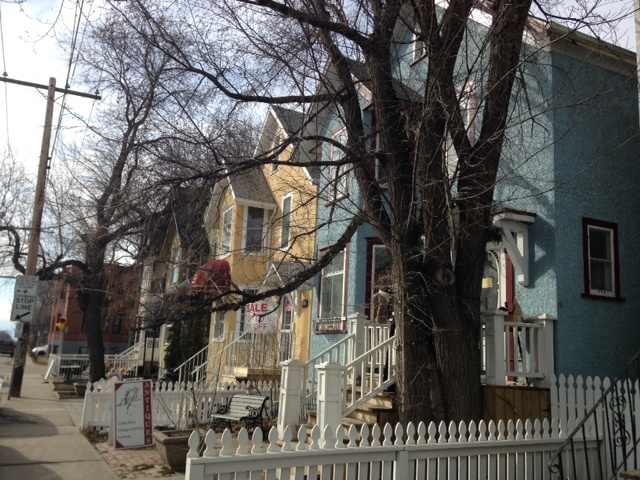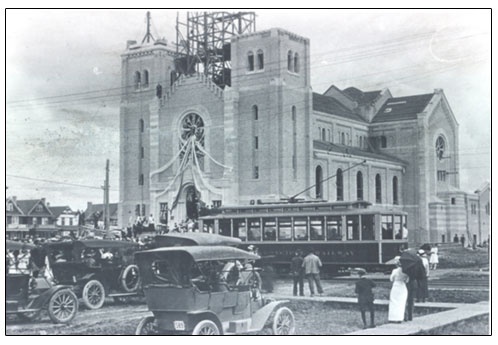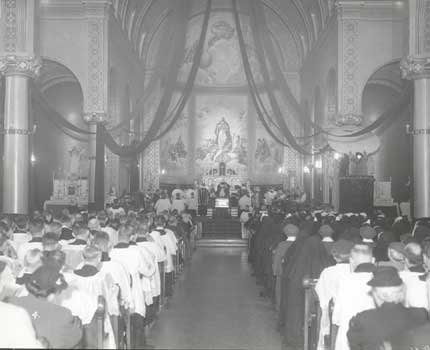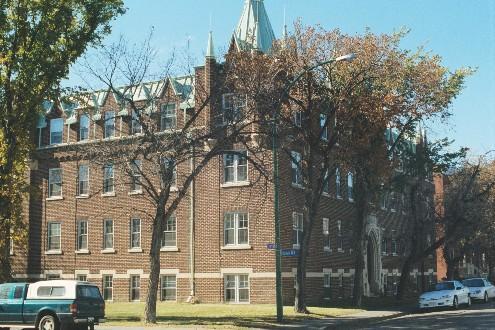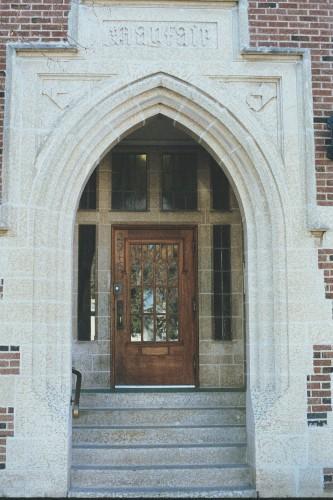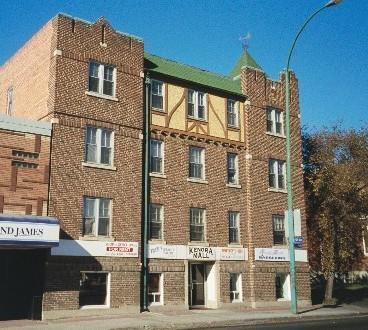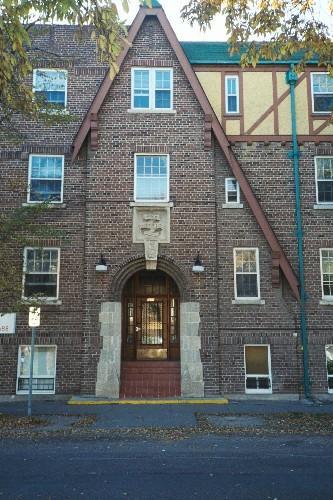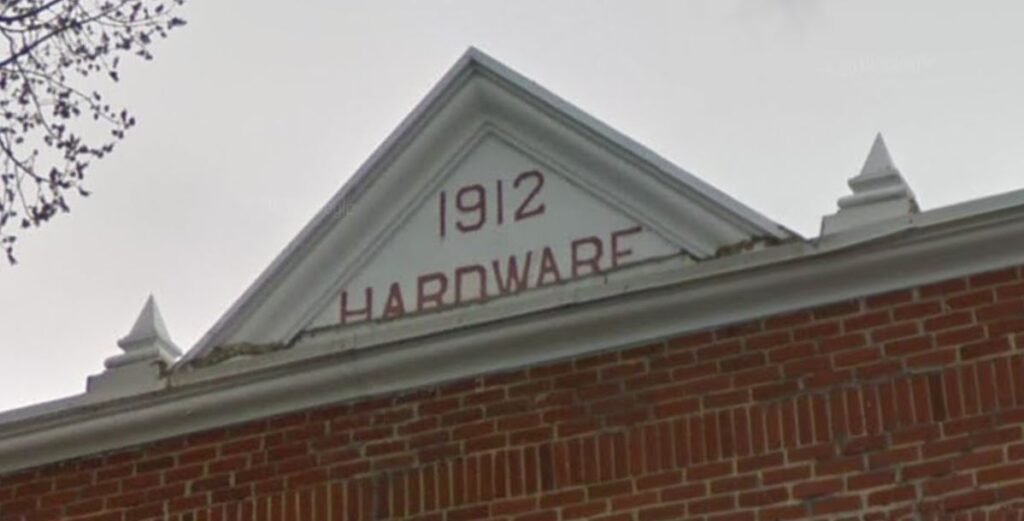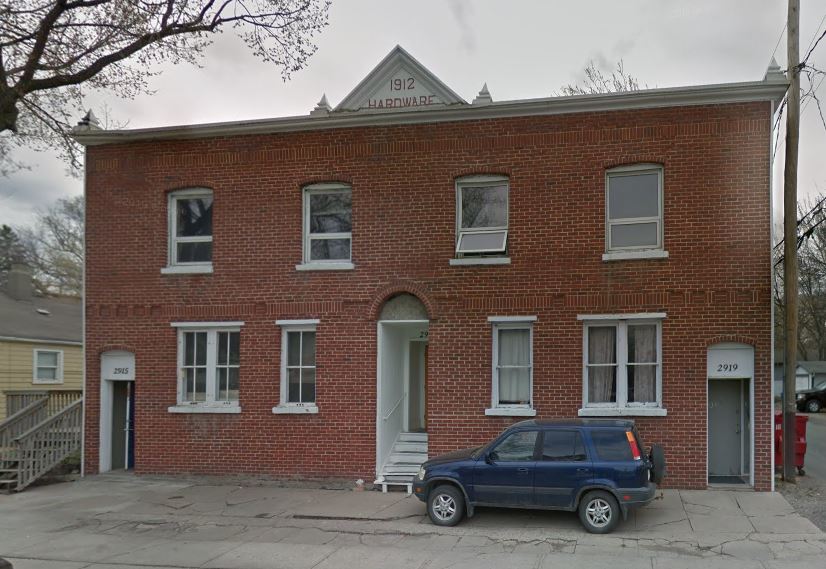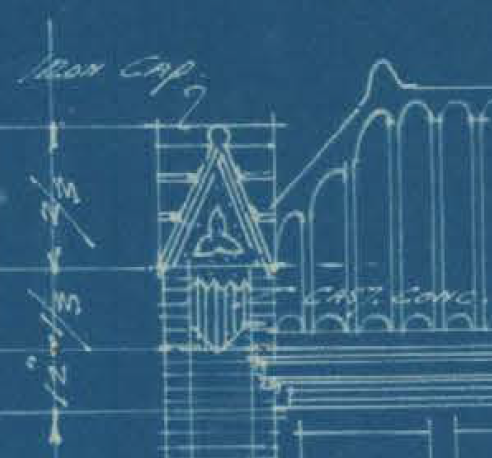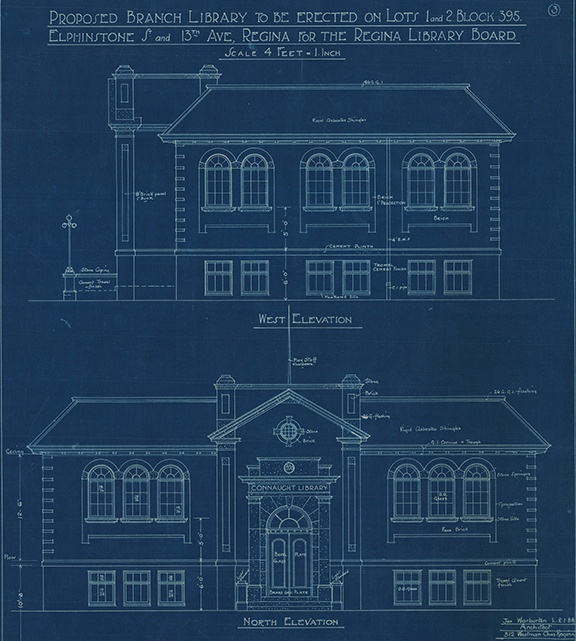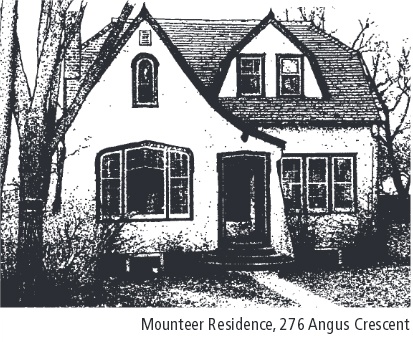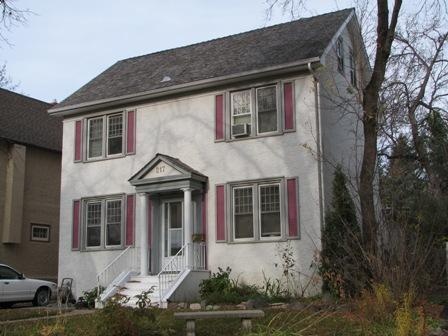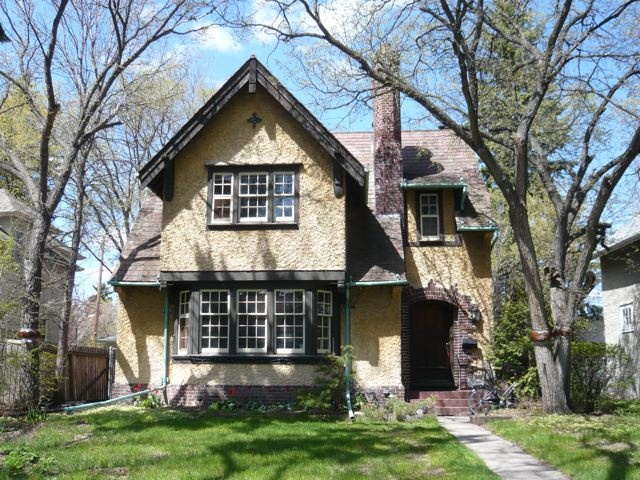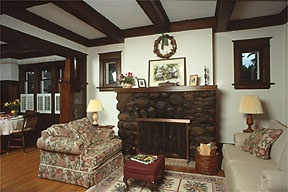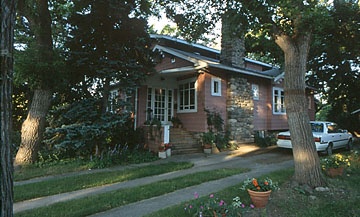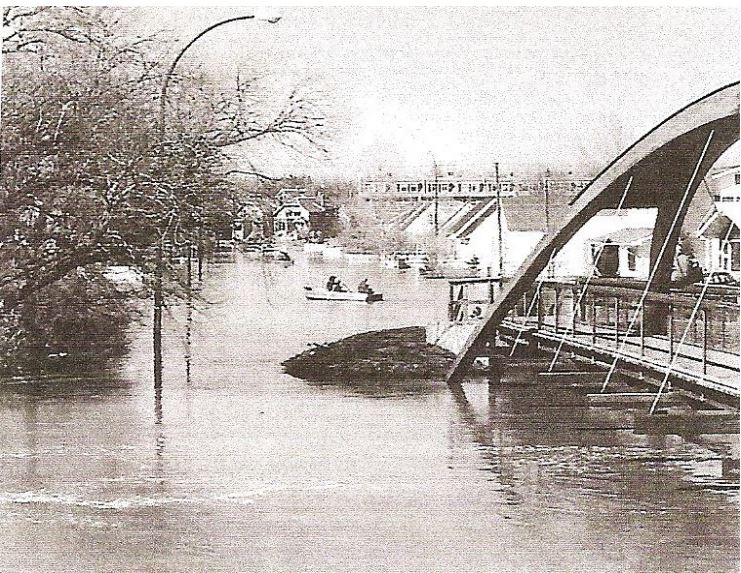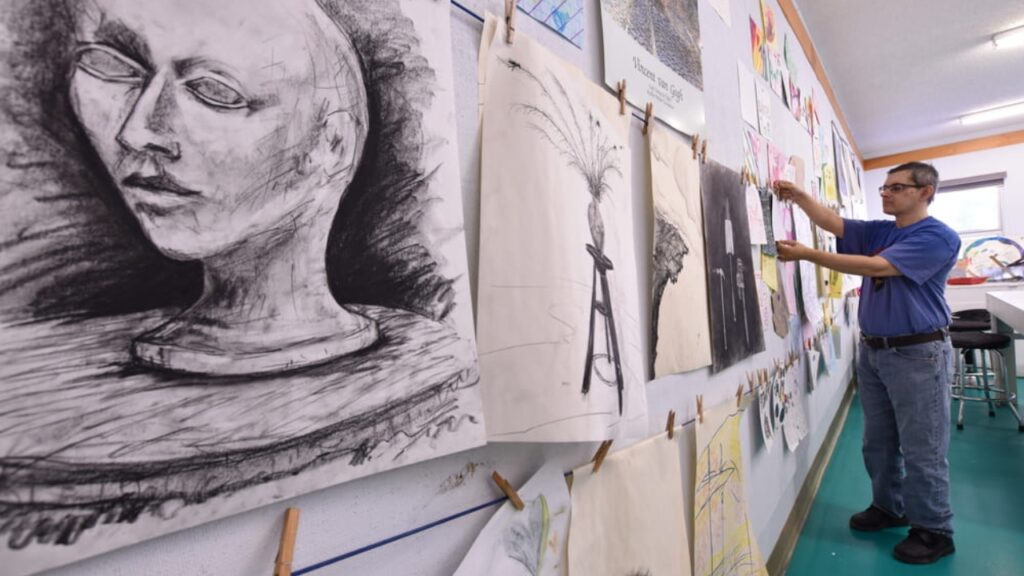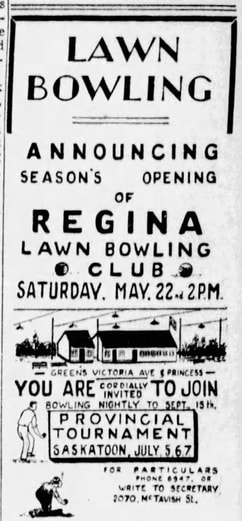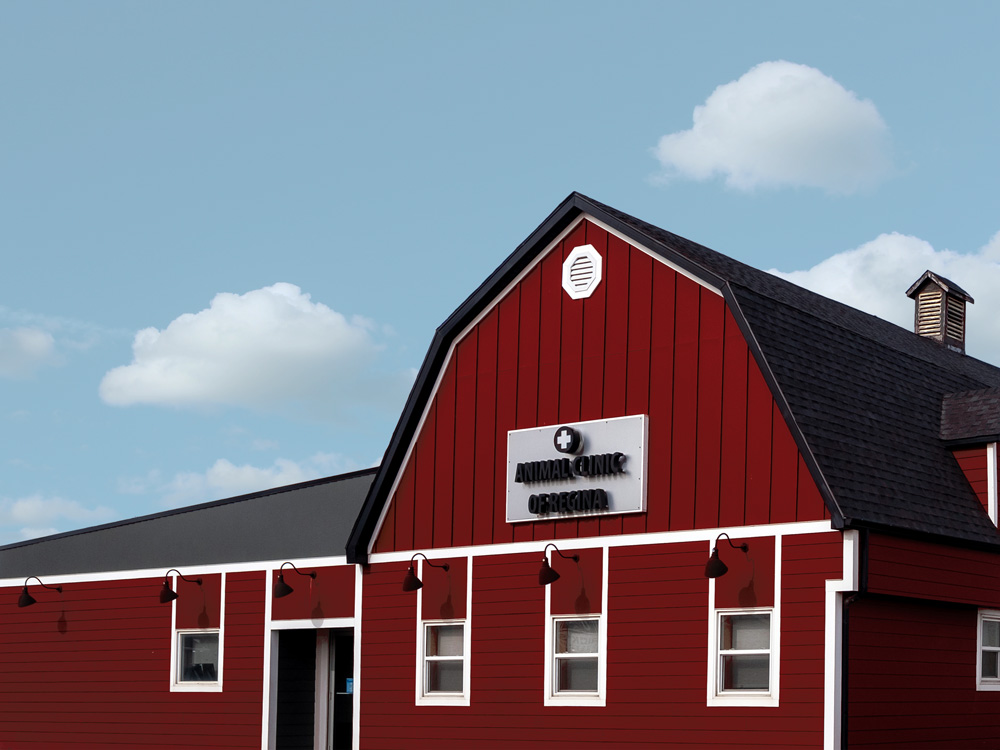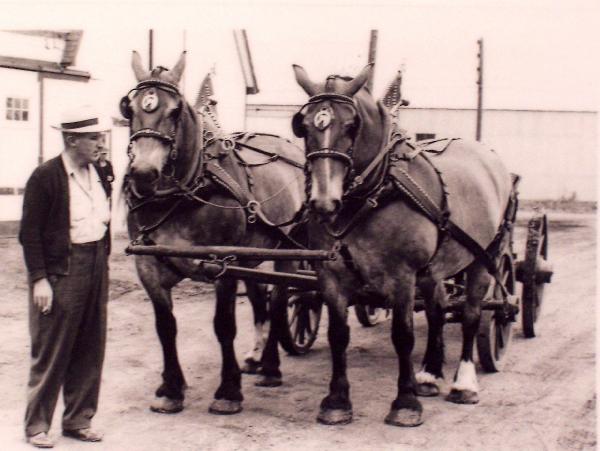WELCOME TO HISTORIC CATHEDRAL VILLAGE
Explore the historic streetscapes and vibrant cultural sites of one of Regina's oldest and most lively neighbourhoods.

Tour created in partnership with the Cathedral Area Community Association
Tour sights
Introduction – The Rassambler
13th Avenue & Albert Street
This land lies within the territory of the Plains Cree, Dene, Lakota, Dakota, Nakota, Saulteaux and Metis Nation. The Albert Street entrance is marked by the Rassambler, a planter and sitting area created from bricks of historic Connaught School. Here you will find a historic plaque describing the school’s history. The planter contains a maple tree, sage and flowering annuals. Following the signing of Treaty 4, Cathedral Village became part of the settlement of Regina, accommodating a pre-First World War population boom. The installment of a 13th Avenue streetcar line in 1911, along with the establishment of schools and churches, gave birth to a new commercial and residential neighbourhood that remains largely intact to this day. Preservation of the historic streetscape has been key to neighbourhood revitalization, providing residents with a walkable, sustainable, liveable community. Cathedral Village has the city’s highest concentration of heritage properties, with 90 buildings named on the heritage holding bylaw list. Please explore!
Calvary Evangelical Church Building
2627 13th Ave
Once the site of Calvary Evangelical Church, 2627 13th Ave. is now home to the sights and sounds of diverse community gatherings at The Artesian.
Stepping into the Artesian Performing Arts Centre, you are greeted by a treasure trove of heritage elements from across Saskatchewan. The wooden ceiling beams are from a grain elevator in Humboldt and the turn of the century tin ceiling comes from Wolseley – but the heart of the building is pure Regina.
The facility began its life as Cavalry Evangelical Church in 1950. The structure was designed and built by prominent Saskatchewan architects Storey and Van Egmond, creators of some of the city’s most renowned public buildings. After decades of religious services at the corner of 13th Ave. and Angus Street, the building was privately purchased in 2009 and its heritage elements were lovingly restored. In 2011, the facility reopened as The Artesian, a multipurpose performing arts centre that welcomes thousands of guests annually.
Several chapters of Regina’s history have been preserved in the interior and will feel like a homecoming for generations of the city’s residents. The building’s main doors were salvaged from Herchmer School, which closed in 2008, and the doors of the theatre from Marian High School, which closed in 1990.
Western Shoe Repairing Building
2816-13th Avenue
2816-13th Avenue was a shoe repair shop from the day it opened in 1930 until the mid-2000s. The first occupant was shoemaker Hann Jacob, owner of Western Shoe Repairing. Jacob handed the business over to John Kusmik in 1941. In 1952, new owner John Fritz renamed the business West End Shoemaker, and so it would remain as a familiar presence on 13th Avenue in the decades to follow, operated by John and John George Fritz.
Cameron Street Row Houses
3024 to 3032 13th Ave. & 2016 to 2071 Cameron Street
Designation: Regina Heritage Inventory, 1989
This is one of the few remaining examples of row housing in Regina. The units were constructed between 1908 and 1912 by the Regina Development Syndicate for an estimated cost of $30,000. The firm Storey and Van Egmond designed the property in a combination of the Georgian Revival and American Craftsman styles. Row houses were popular in Britain during the Georgian period, a time of major urban growth between the years 1714 and 1830. Throughout the United Kingdom row houses have endured the passage of time and today remain the main housing stock in major cities such as London and Dublin.
Their appearance in Regina reflects the city’s rapid population growth before the First World War. Developers built a few of them to serve a new market of middle-income buyers. However, they did not become a common housing form in Regina
Safeway Store Number 352
3004 13th Avenue
Built in 1929, this building became one of two original sites of the Cathedral Area’s longest-standing grocery store. Safeway Grocery Store Number 352 opened in 1930, near Store 353 on Elphinstone and 13th, and remained operating at this location until 1960, when it moved to its current location on the 2900 block of 13th Avenue.
In 1961, J. Alex MacKenzie purchased this building to open a jewelry store, along with the adjoining address, 3000 13th Avenue, as a location for the head office of MacKenzie Jewellers. In addition to the 13th Avenue jewelry stories, MacKenzie Jewellers had locations on 12th Avenue and the Golden Mile Shopping Centre at the time.
The former MacKenzie’s head office later became home to CFMQ FM Radio (Q-92 FM). FM radio was an upstart media platform in the 1970s, valorized in films like FM and a hit song by Steely Dan, FM (No Static At All).
Though the music has fallen silent at 3000-13th Avenue — today an empty lot — the aroma of flowers still wafts from Gale’s Florist at Number 3004, a bustling shop filled with flowers, wedding decorations and household décor, and one of the Cathedral Area’s oldest businesses.
Flood Land Company Residences
3126 to 3136 13th Avenue
This row of houses was built by the Flood Land Company in 1912. Their addresses number from 3126 to 3136 13th Avenue. The buildings have served the neighbourhood for more than 100 years as homes and shophouses. They are notable for their shallow set-back from the street, making them attractive to the small business owners who began setting up shop here in the mid-1990s.
The corner property, 3136-13th Avenue, is currently the location of 13th Avenue Coffee, a popular neighbourhood gathering spot. The first resident was J.W. Thomas, vice-president of the Young-Thomas Soap Company. Mr. Thomas lived in the house until 1918, when it briefly served as the Jesuit College. Two years later, A.J. McKenzie, a music shop owner, moved in. The shop, A.J. McKenzie & Co., was located at 1759 Hamilton Street. An advertisement of the time says the store offered pianos, player pianos, phonographs and Victor records. Other early residents were: 1921 – George Morgan, yard superintendent at Whitmore Bros., a coal and wood yard. 1923 – Mrs. Ellen Murray, a widow. 1925 – Ernest and Cecile Calleaux. Ernest was the caretaker at Holy Rosary Cathedral, and Cecile was a typist at the Royal Bank. 1926 – Mrs. Gertrude Wright and Mrs. Isabella O’Reilly. 1927 – H.Lett, Sargeant-at-Arms at the Legislative Building and Thoms Lumsden, a carpenter. 1928 – Edwin A. Allan, a salesman
The next building east, 3134-13th Avenue, is today home to Satori Hair Studio. Early residents included: 1915 – Maurice Burke, a comptroler at “The Leader” newspaper. 1920 – James Middleton, an inspector with the provincial Telephone Department. 1922 – John H. McNath, a carpenter. 1923 – Thomas Jacklin, a “traveller” – the term used at the time for a travelling salesperson. 1925 – Reginald C. Dawson, assistant manager at Metroplitan Life. 1928 – Percy McIntosh, an employee of Capitol Roofing. In 1998, the building welcomed its first commercial resident, a shop called La Petit Rose.
Early residents of 3130 13th Avenue included
1915 – Albert Shaw, a carpenter
1920 – Joseph Mills, a meter reader
1924 – Mrs. Ellen Murray
1927 – James Moore
It has since been converted into a commercial operation, and is today home to Le Voilà Boutique.
Early residents of 3128 included:
1915 – Bernard Richter, a meat cutter
1916 – William H. McEwan of the law firm Martin, McEwan & Martin, located at 1853 Hamilton St.
1918 – Neil McFayden, superintendent for the Sask. Elevator Co.
1919 – Thomas C. Chard, a clerk in the provincial Department of Telephones.
1920 – Herman E. Worth, an operator for Canadian National Railways.
1930 – A.L. Buck, a land titles office clerk.
In 1992 it became the home of The Cat & The Fiddle Antiques.
The final home in the row, 3126, has been a private residence for more than a century, although it got off to a rocky start. If the Flood Land Company hoped to turn a quick profit with their new homes, this address was a challenge. Built in 1912, it sat vacant for five years until Fred Nordyke, a comptroler for the Advance Rumley Thresher Company, moved in in 1917. Mr. Nordyke lived there just one year, leaving the house vacant again until 1922. That year, Mrs. G.M. Yorty and Mrs.Louisa Holland moved in. The two women stayed a year, and were replaced by Robert E. Cughan, a lumber inspector. When Mr. Cughan moved out, the house sat vacant another year. After that, it had a steady succession of tennants, including Fred. G. Wilcox, a labourer (1925-1926), Benjamin Segal, a “cattle director” (1927-1929), and G.A. Copely, a timekeeper for Bird, Woodall & Simpson, Contractors and Engineers.
Holy Rosary Cathedral
2104 Garnet Street
Designation: Regina Heritage Inventory, 1989
Founded in 1913, the soaring spires of Holy Rosary Cathedral gave the neighbourhood its current name. It was designed in the Romanesque Revival style by the firm of Joseph Fortin of Montreal, who also designed the Roman Catholic cathedrals in Saskatoon and Gravelbourg.
Smith Bros. & Wilson built the cathedral at a cost of $200,000. It was a labour of many years. The first sod was turned in June 1912, just weeks before a devastating cyclone swept through Regina. The first mass took place in the basement on December 8, 1912, and in June 1913 the building’s cornerstone was blessed by the Papal Ambassador to Canada. A photo of the gathered crowds shows the building’s signature spires were still under construction. The building was finally completed in 1917.
Inside is a 1930 Casavant pipe organ that was fully restored in 1993. Named the McGuigan Casavant Organ, it is one of the finest in Canada, attracting musicians from around the country. A special scholarship program helps young students train on the instrument.
There are also 33 stained-glass windows designed in 1951 by the French artist André Rault. Detailed descriptions of each window can be found on the website of the Institute for Stained Glass in Canada.
On April 12, 1976, a fire broke out and gutted the interior. Nearby Westminister United Church offered a temporary home for the congregation while repairs were made. The stained-glass windows were not damaged, and were fully restored in 2002 by David Johnson of the Royal Academy of Stained Glass Artisans.
This property has been on the Regina Heritage Holding Bylaw List since 1989. It remains a very active cathedral, filling 13th Avenue with lively crowds whenever masses, weddings, music concerts, and other events are held.
As the parish website states, “Far from being a museum, Holy Rosary Cathedral is a vibrant Christian community that gives thanks for the generosity and foresight of its founders, and looks forward to the future with hope and faith.”
The Mayfair Apartments
2915 14th Ave
Designations: Municipal Heritage Property, 1999
Canadian Register of Historic Places, 2006
When they opened in 1929, the Chateau-style Mayfair Apartments represented refinement, luxury and state of the art residential living. Today, they remind Reginans of the importance of preserving our shared history.
The four-storey, Chateau-style building at 2915 14th Ave. is better known as the Mayfair Apartments. Construction was completed on the apartments, which are faced with variegated dark-brown brick, in late 1929. The Mayfair Apartments were designed by prominent Regina architectural firm, Storey and Van Egmond, who also designed other Regina landmarks in the same Chateau style. The apartments were constructed from materials and equipment supplied exclusively by local companies, including construction company Smith Brothers and Wilson. Ironwork was provided by the Dominion Bronze and Iron Company.
In fact, the architecture of the apartments combines the Chateau style with Scottish Baronial elements. The Mayfair Apartments demonstrates an elaborate and consistent application of this style, which was popular in Canada in the first decades of the twentieth century. The Mayfair Apartments exhibits many key elements of the Chateau style, such as the steeply pitched Mansard roof line with stepped gable and hip roof dormer windows, and elements of the Scottish Baronial style, such as tourelles, turrets, and spires. In Canada, the Chateau style was typically applied to railway hotels and some public buildings prior to the Second World War. Access to the building is provided by a recessed main entrance with a Gothic-arched opening executed in Tyndall Stone.
At the time the apartments were opened to the public in October of 1929, The Regina Leader touted them as some of “the most modern apartment blocks in Western Canada”. Each apartment was outfitted in state-of-the-art fixtures and appliances. Each unit came equipped with an electric fireplace and a Hotpoint Hi-Speed electric range oven, installed by Sun Electrical Company, whose offices were located on the 1800 block of Scarth Street. Each apartment also featured electrical refrigeration, which was rare in the late 1920s. Refrigerators were provided by the Regina branch of the Frigidaire Corporation, whose manager was one of the developers of the Mayfair Apartments.
The heritage value of 2915 14th Avenue also lies in its association with Provincial Apartments Ltd., a company created in 1928 by prominent business leaders in the local community. The company was formed in Regina during a period of economic prosperity and rapid population growth. Provincial Apartments Ltd. was a response to the decision by General Motors of Canada to build an automotive assembly plant in Regina, which involved the relocation of many of their workers from Ontario.
The heritage value of 2915 14th Avenue also resides in its association with several long-term and prominent residents. Several of these residents led distinguished careers in the public and private sectors. The list includes former Saskatchewan New Democratic Party minister Gordon MacMurchy, who served in Premier Allan Blakeney’s cabinet from 1971 until 1982, as well as sportsman Morris Burns who resided in the apartments from 1935 until his death in 1987.
2915 14th Avenue was also the site of the former 14th Avenue Methodist Church, which was constructed in 1912. The site has a historical connection to the early development of Regina and the formation of the United Church of Canada in 1925, and the merger of the church’s congregation with that of Westminster Presbyterian Church.
The Kenora Apartments
2601 14th Avenue
The Tudor and Gothic Revival elements of the Kenora Apartments combine to transport Reginans back to the early and optimistic boom days of our city.
The Kenora Apartments look like they would fit in well in London in the early twentieth century. Instead, the Storey and Van Egmond-designed building is one of Regina’s most architecturally significant.
The four-storey building was constructed in 1928 and is made of checkered dark-brown brick. The apartments were originally constructed for Dr. W.A. Henderson of Kenora, ON and built by local Regina firm Poole Construction. The historical importance of the Kenora Apartments lies in their status as one of a group of apartment blocks constructed along 14th Ave. between 1914 and 1930, built to accommodate middle- and higher-income clientele in a rapidly growing city. Other apartment blocks that date from a similar period include the Mayfair Apartments, Linden Manor and the Chateau Apartments. These buildings make up the most intact collection of elegant residential blocks constructed in Regina during a period of economic prosperity and optimism for the future. The initial design plans called for a mixed-use residential and commercial building but were eventually changed to reflect only residential use. The current retail locations on the ground floor were not added until decades later.
The unusual architectural style of the apartments combines both Tudor Revival and Gothic elements. Some of these features include a semicircular arch entrance, cat-slide roof, decorated bargeboard, shingles cut to imitate medieval thatching, and stucco and half-timbering on the upper level. The building’s main entrance is defined by several decorative elements in Tyndall stone, including a semicircular rowlock arch, supporting columns, building sign and a carved keystone.
The Kenora Apartments have several architectural features that make the building look as if it could be the set for a movie set in a Gothic castle. These include the crenellated towers, decorated parapets, metal plaques of heraldic knights, and the pyramidal roof topped off with a weathervane.
The building was designated a Municipal Heritage Property in 1984.
Regina Hardware Block
2915-2919 15th Ave.
This was the short-lived home of Regina Hardware Company Ltd., founded in 1912.
Founder R.S. Dyble began hardware sales out of a home on Cornwall Street. At the time, 15th Avenue had no buildings west of the 2700 block. Then, in 1912, construction began on what was described as a “new house” at 2917 15th Avenue.
When completed it did look more like family housing than a business, perhaps required by the City for a residential street.
The variety of elements is unique compared to other buildings of that era. Its well thought-out design features three different arches for the doors and windows. The bricks are a veneer applied to a wood frame structure. Soldier courses for the lower windows are different from those for the upper windows. The stretcher on the lower row is somewhat recessed and purely for decorative purposes. This is an unusual form of bricklaying, possibly unique in Regina.
The source for the bricks is unknown but there are indications that they may have originated from brick factories in Medicine Hat or Redcliff, Alberta. The pinnacles atop the pressed metal parapet and roof-line are short yet classically pyramid-shaped, likely bought from a catalogue supplying prefabricated sheet metal elements for the entire parapet complex. The diminutive pediments were likely a special-order item from the same catalogue.
The Regina Hardware Block contained three spacious units, each with its own street number. This layout offered a unique life-work arrangement. As company president, Mr. Dyble took up residence in Number 2919, the west unit. His secretary-treasurer, H.S. Woolatt, and family moved into Number 2915, the east unit.
Mrs. Woolatt became an active civic leader in the city’s new neighbourhood. She played piano for gatherings of the 14th Avenue Ladies Aid Society, and sat on the Parlour Meetings Committee of the West End Women’s Christian Temperance Union.
The hardware business proudly took up the centre ground floor unit, Number 2917. The lack of large store-front windows is noticeable, and would be unusual if the business were located on 13th Avenue or downtown. But the building’s attractive design fit nicely among the new homes appearing on 15th Avenue.
The company’s initial specialty was installing home heating systems for other contractors. As the construction boom grew, so did the services of the Regina Hardware Company. In April 1914, the store began running a regular classified ad in the Regina Morning Leader, advertising “Hecla furnaces, cornices, tanks, eaves-troughs, etc.”
But within five years of operations, the Regina Hardware Company was no more. By 1917, the store was no longer listed in the city directory. On April 3rd of that year, a classified ad for a suite for rent appeared, with the Regina Hardware Block listed as the location. Prospective renters were advised to contact the Saskatchewan Mortgage and Trust Company.
Company president Dyble likewise disappeared from the city directory, while secretary-treasurer Woolatt re-appeared at an address on Robinson Street. His new trade was noted as a tinsmith. Mrs. Woolatt continued to appear in the press as a West End temperance activist.
While Regina Hardware didn’t survive long, the company left a lasting legacy in Regina’s Cathedral Village. The words ‘Hardware 1912’ are still proudly displayed above what are today residential suites. Were it not for this small decorative pediment, the Regina Hardware Block’s chapter in the story of a growing new city would be forgotten.
Safeway Store Number 353
3424 13th Avenue
In August of 1929, Safeway Stores Ltd. announced that they would be opening their first Regina shops. “Large, airy, light, immaculately clean, unusually attractive and conveniently arranged,” Safeway Stores claimed to Regina residents that they would be “decidedly different from the stores you have been accustomed to.” Conceived as convenient neighbourhood shops, they brought “downtown prices almost to the door of the consumer.”
Designed by Regina architects Storey and Van Egmond and constructed by Smith Brothers and Wilson, work commenced on the first four Regina stores in the fall of 1929. On December 21, three stores celebrated a simultaneous grand opening, including Safeway Store #353, located on 13th Avenue near Elphinstone, in the current Slate Fine Art Gallery building. Opening day prices included a loaf of Safeway Bread, wrapped in wax paper, for 5 cents; Safeway butter, packed in “new style wax cartons”, for 38 cents a pound; a dozen eggs for 39 cents; and three candy bars for 10 cents.
Constructed at a cost of $13,000, these attractive new buildings sported brick construction accented with black tile bulkheads, red Spanish tile roofs, and fronts of plate glass and copper. The distinctive trefoil ornamentation, made of cast concrete and, at the time, capped in galvanized iron, is still visible at the top of the building’s masonry piers. Perhaps to enhance the friendly neighbourhood atmosphere and improve accessibility for all, it was decided some time prior to construction that all store entrances would be at street level with no steps required to enter.
As the decades passed, Safeway’s small neighbourhood stores were closed in favour of larger flagship-style stores. Safeway vacated their 13th Avenue and Elphinstone building in 1942 and, on August 31 of that year, Palm Grocery and Meat Market set up shop. Previously located one block to the west, the newly relocated shop improved service by installing a rotary telephone system offering five phone lines and employing six boys with bicycles to see that “orders are received quickly and … on their way in much shorter time than previously.” A staff of eleven oversaw grocery and meat departments equipped with modern conveniences such as two fifteen-foot show windows facing 13th Avenue – one of which housed a sprinkler system for perishables – attractive display gondolas down the center of the store, and a candy and tobacco counter to the right.
By all accounts, Palm Grocery was a good place to work: in 1942, the proprietor was fined in city police court for paying his butcher too much to manage the store while he was away serving in the army, as $50 a week plus commission was beyond that allowed under the wartime wage control board regulations. In June of 1941, bicycle delivery boy Roy Smith reported his red Crescent bicycle stolen from behind the store; luckily for him, the Palm advertised jobs with “good wages” for “boys with or without bicycles”!
In August of 1953, the Winnipeg grocery chain Shop-Easy Stores Ltd. sought locations in Regina and purchased the Palm Grocery’s chain of three locations. Supplying “the very finest in fruits and vegetables” and “employing one man who has nothing to do but check the quality of the meat”, the store was so confident in the quality of their meat that they offered unsatisfied customers double money back.
In the second half of the century, 3424 13th Avenue also housed an electronics store and a furniture store.
Slate Fine Art Gallery relocated to this location in 2019.
Connaught Library
3435 13th Avenue
Designations: Municipal Heritage Property, 1984
Canadian Register of Historic Places, 2006.
In 1928, the West End Elector’s Society began lobbying the Regina Public Library Board for a library branch to serve their neighbourhood. Three years and $22,000 later, Connaught Library Branch opened its doors. It was designed by Joseph Warburton, who also designed Albert Library. The Poole Construction Company began work on the library in 1930 and completed it in 1931. The building’s Classical Georgian architecture represents “strength, permanency and stability,” according to the Canadian Register of Historic Places.
The compact one-storey library is masonry construction with a gabled roof. The entranceway features carved Manitoba Tyndall Stone, arched windows, and an oriel window above the main doors.
The library has welcomed a steady stream of patrons over the years, and serves as a gathering place for community events. It is an important community hub for Cathedral Village, offering educational, cultural and children’s programs. Inside are more than 30,000 books, as well as DVDs, CDs, public computers, and meeting rooms.
In 1984, Connaught Library received Municipal Heritage Property designation. It was nearly closed and demolished in 2003, but a feisty public campaign convinced the city’s mayor that Cathedral Village needed a library, and that the beautiful historic building should be repaired.
In 2006, Connaught Library Branch was listed on the Canadian Register of Historic Places. Today it is one of the oldest buildings in Regina’s library system. Active citizens demanded a library in 1928, and have continued to defend its existence, a living testament to how much citizens value Connaught Library Branch.
Mounteer Residence
276 Angus Crescent
Designation: Regina Heritage Inventory, 1989
This 1929 house was built for Dr. Edwin Mounteer, a dentist who lived here until 1941. It features a Tudor window and a cat-slide roof. The City of Regina neighbourhood walking tour book notes that it is similar to the house located at 278 Angus, both constructed by Waterman-Waterbury Manufacturing Company the same year. Although unconfirmed, this ‘sister house’ was likely built by the same architect, Milton Campbell.
Sneath Douglas Residence
217 Angus Crescent
Designation: Municipal Heritage Property, 1997
Canadian Register of Historic Places, 2009
This home was built in 1914 and declared a municipal heritage property in 1997 in recognition of Edwin Sneath, a prominent local lawyer who lived in the home from 1922 to 1944. However, its most well known resident was Tommy Douglas who lived in this home from 1944 to 1962.
The Douglas’s lived in this home the entire time Tommy Douglas was Premier of Saskatchewan. There were surely many conversations around the dining room table or with a cup of tea in the living room on the momentous advancements made by the government Douglas led, including the implementation of the health care system which has since become Canada’s national Medicare system. These walls surely hold many stories if only they could talk!
Douglas is recognized as one of the founders of Medicare. He was popularly recognized as the Greatest Canadian in a 2004 national poll.
Over the years the various owners of the home have renovated and updated the interior. As a result, it is very nearly impossible to discern what interior aspects are original and what are the result of the changes made over the years. There are a few details which are believed to be original – oak French doors into the living room for example – that fortunately have been retained. There are also a few details which are believed to be from the era the Douglas’s lived in the home that have been retained.
The current owners bought the home in 1996 and did various renovations including restoring the pillars supporting the front portico. The home’s interior was extensively renovated in 2013-14 including home infrastructure updates.
The front façade of the home has largely kept its original appearance, renovations that have been made have not changed the character of this heritage property.
More information can be found in Canada’s Registry of Historic Places.
Portnall Residences
109 Angus Crescent
Designation: Regina Heritage Inventory, 1989
This 1927 home was designed by and built for Francis Portnall, one of Saskatchewan’s most celebrated architects. He lived here until his death in 1976. Portnall designed many prominent Regina buildings, including the Knox-Metropolitan United Church, the Federal Building, the Norman McKenzie Art Gallery, the Grenfell Apartments, Court of Queen’s Bench, and historic Davin, Thompson and Herchmer Schools. He also designed many Regina homes, including 56, 139, and 190 Angus Crescent. He designed a home for his sister across the street, at 130 Angus, which was demolished in 2014.
His home designs are known for their creative details. This Tudor Revival styled home features diamond-shaped detailing under the front gable composed of glass bottle bottoms, and segmented octagonal chimney stacks constructed of red brick. The home has been on the Regina Heritage Holding Bylaw List since 1989.
Kirkpatrick Residence
2724 Angus Boulevard
Designation: Regina Heritage Inventory
There’s a reason this Arts and Craft-style home has an air of grace to it. The Kirkpatrick Residence, built in 1914, is made from materials originally meant for the Chateau Qu’Appelle Hotel. Where is this hotel, you might ask? If you dug deep, you would find its foundations underneath the Royal Saskatchewan Museum at College Avenue and Albert Street. The Chateau Qu’Appelle was designed as a grand railway hotel for the Grand Trunk Pacific in 1913, but the railway company went bankrupt before its completion. How then did some of the materials end up here? The connection was James Kirkpatrick, the superintendent of Grand Trunk’s passenger depot. He obtained some of the hotel’s stones and beams to build a home beside Wascana Creek. The building’s historic architecture has been well maintained. The Kirkpatrick Residence features solid oak woodwork, wood shingles and fieldstone foundations and chimney. The interior ceiling is beamed with exposed oak and has a unique fieldstone fireplace. Its location includes beautiful shade trees and quick access to a walk in nature along Wascana Creek. The residence is on the City of Regina’s heritage holding bylaw list.
Riverside Reach
Wacana Creek Rehabilitation Project
To protect creek side streets from flooding, in 1956 the City of Regina built a dike along Wascana Creek called the Flood Protection Works, with extensions carried out in 1971 and 1974. By 1997 the works were beginning to deteriorate.
With advice from citizens, the City carried out reconstruction of the Flood Protection Works between Albert Street and Elphinstone, using creative open space planning and geotechnical and bio-engineering technology. The detailed design and construction was undertaken in three phases in 2002, and was completed in 2005. The result was improved natural habitat and a popular walking path.
Neil Balkwill Civic Arts Centre
2400 Elphinstone Street
The Neil Balkwill Civic Arts Centre, named in honour of the city’s superintendent of recreation Neil Balkwill and designed by architect Willem de Lint, opened at a special reception on Friday, September 10, 1982. Introduced as a civic center “devoted to demonstrations and displays of weaving, jewelry making, woodworking, photography and a number of other arts and crafts,” the center had devoted facilities and materials for a variety of disciplines.
First proposed in 1976, the project was initially hampered by issues such as finding a perfect location both accessible by transit and offering ample parking space. Many advocates, including Neil Balkwill, worked tirelessly to make the idea a reality and construction finally began in Les Sherman Park in the spring of 1981. The building was completed in 1982 at a cost of $1 million. For the opening events, the gallery featured works from the Saskatchewan Arts Board and the Mackenzie Art Gallery and provided demonstrations of various disciplines including weaving and spinning, quilting and stitchery, and woodworking.
The Neil Balkwill Civic Arts Centre has provided a creative community space for Regina residents of all ages and skill levels, and for countless community groups and clubs, for several decades. In addition to its dedicated facilities, the center houses the Art Gallery of Regina, has held concerts, art shows and sales, fundraisers, reading series, and coffeehouses, and has provided program and meeting space to numerous arts and crafts guilds.
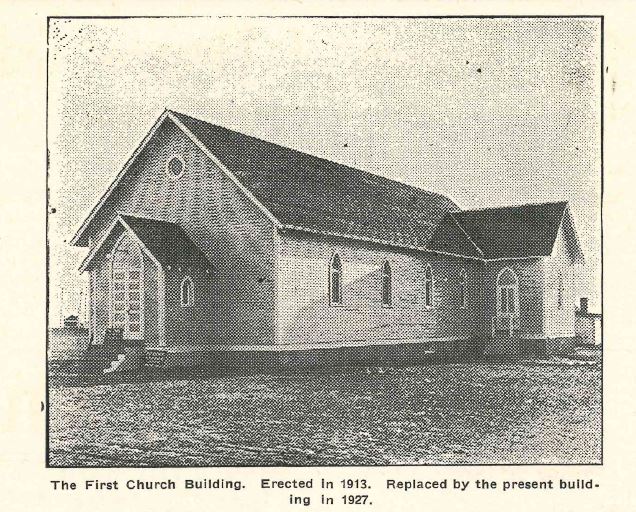
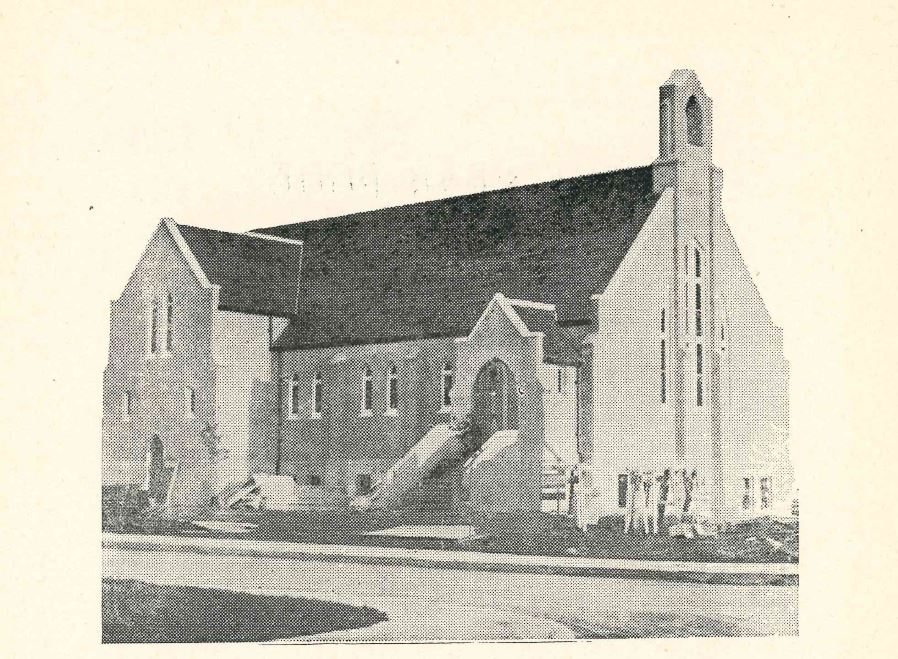
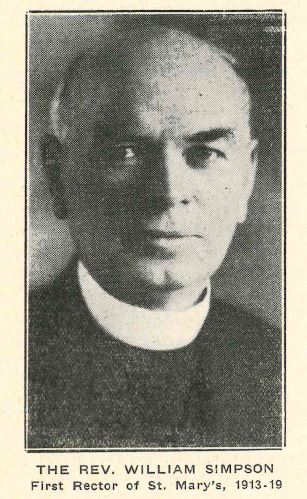
Photos are from the parish’s 21st anniversary yearbook, published in 1934. PDF Download.
St. Mary the Virgin Anglican Church
3337 15th Avenue
St. Mary The Virgin Anglican Church is almost as old as Regina itself. Founded in 1913, the church’s parishioners first gathered for worship in a small Parish Hall followed by a slightly larger frame building until sufficient funds were raised for the current church building on 15th Ave. to be constructed. St. Mary’s was the second Anglican Church in Regina, following the establishment of St. Paul’s downtown in 1882. Regina was growing quickly in the early 1900s, and another church was needed to meet the needs of Anglican adherents in the city. St. Mary’s was built to “comprise that part of the city bounded by the CPR track in the north and the city limits in the south and by the west side of Rae Street to the East and the city limits in the west.” In the early years of the church, some parishioners had difficulty accessing it “owing to the intersection of Wascana creek.”
St. Mary’s has faced more than its fair share of challenges over the years. The year after the church was built, the First World War broke out, depriving the congregation of many of their “bravest and best.” Not long after, the church courageously weathered the Depression years. A 1934 message to parishioners in a booklet celebrating the church’s 21st anniversary reads, “These years of depression will pass, and if we have learned our lessons rightly, we shall without a doubt, achieve great things in the future.”
Plans were drafted for the current church building in 1927 and construction started that same year to a final cost of $24,048.20 – or about $410,000 in today’s money. The original plans were drawn up by Stan Storey of renowned architectural firm Van Egmond and Storey
Leslie Bowling Greens
3820 Victoria Avenue
The Regina Lawn Bowling Club’s long history begins in 1912, when land for a green was donated by the Provincial Government. In 1922, when the land was reclaimed for development, the club moved to a location near the General Hospital, donated by the City. In August of 1930, when construction on a new building began behind the General Hospital, the Regina Lawn Bowling Club was once again without a home. For this reason, the 1930 provincial tournament was held in Saskatoon instead of Regina, and the club prepared from a space at the Exhibition Grounds, made available for a nightly fee.
Four men’s rinks and two ladies’ rinks were sent to Saskatoon for the 1930 tournament, which began on Labour Day, on a special chartered coach on the Canadian National Railway. On October 9, the club held their annual windup banquet at the Champlain Hotel and, for the first time, the club’s ladies were present. They were congratulated on their achievement at the provincial tournament, having won three first place and one second place spots. Some of the prizes won by the club included silver plate, silver cigarette cases, cuff links and Wahl pencils. Following the banquet, the 85 attendees proceeded to the Metropolitan Theatre for an exclusive show.
The club remained at the Exhibition Grounds until 1932, when Mayor James McAra officially opened the new greens, located at the present-day Victoria Avenue location, for the Victoria Day Games. The following Labour Day, the provincial tournament was back in Regina and was opened by, once again, Mayor James McAra at the club’s new location. 125 bowlers from Regina and Saskatoon played until midnight the first night, and the three-day tournament was heralded as “one of the most successful in history, the weather being ideal throughout and the new home of the Regina bowlers aiding to the enjoyment of the visitors.”
With the world at war and most Regina residents’ minds otherwise occupied, the onset of World War II meant an interruption in the club’s activities. However, despite larger events such as the provincial tournament being cancelled in some years, smaller events and local tournaments were organized at the club’s greens. By the 1970s, the club was hitting its stride once again with over a hundred members and construction of a new clubhouse. In the 1980s, the club got its fourth green and is, today, one of only three four-green lawn bowling facilities in Canada. The four greens have hosted seven Canadian championships, three inaugural championships, and the international North American Challenge.
Read more about the club and its history at www.reginalawnbowlingclub.ca
Safeway Store Number 353
3424 13th Avenue
In August of 1929, Safeway Stores Ltd. announced that they would be opening their first Regina shops. “Large, airy, light, immaculately clean, unusually attractive and conveniently arranged,” Safeway Stores claimed to Regina residents that they would be “decidedly different from the stores you have been accustomed to.” Conceived as convenient neighbourhood shops, they brought “downtown prices almost to the door of the consumer.”
Designed by Regina architects Storey and Van Egmond and constructed by Smith Brothers and Wilson, work commenced on the first four Regina stores in the fall of 1929. On December 21, three stores celebrated a simultaneous grand opening, including Safeway Store #353, located on 13th Avenue near Elphinstone, in the current Slate Fine Art Gallery building. Opening day prices included a loaf of Safeway Bread, wrapped in wax paper, for 5 cents; Safeway butter, packed in “new style wax cartons”, for 38 cents a pound; a dozen eggs for 39 cents; and three candy bars for 10 cents.
Constructed at a cost of $13,000, these attractive new buildings sported brick construction accented with black tile bulkheads, red Spanish tile roofs, and fronts of plate glass and copper. The distinctive trefoil ornamentation, made of cast concrete and, at the time, capped in galvanized iron, is still visible at the top of the building’s masonry piers. Perhaps to enhance the friendly neighbourhood atmosphere and improve accessibility for all, it was decided some time prior to construction that all store entrances would be at street level with no steps required to enter.
As the decades passed, Safeway’s small neighbourhood stores were closed in favour of larger flagship-style stores. Safeway vacated their 13th Avenue and Elphinstone building in 1942 and, on August 31 of that year, Palm Grocery and Meat Market set up shop. Previously located one block to the west, the newly relocated shop improved service by installing a rotary telephone system offering five phone lines and employing six boys with bicycles to see that “orders are received quickly and … on their way in much shorter time than previously.” A staff of eleven oversaw grocery and meat departments equipped with modern conveniences such as two fifteen-foot show windows facing 13th Avenue – one of which housed a sprinkler system for perishables – attractive display gondolas down the center of the store, and a candy and tobacco counter to the right.
By all accounts, Palm Grocery was a good place to work: in 1942, the proprietor was fined in city police court for paying his butcher too much to manage the store while he was away serving in the army, as $50 a week plus commission was beyond that allowed under the wartime wage control board regulations. In June of 1941, bicycle delivery boy Roy Smith reported his red Crescent bicycle stolen from behind the store; luckily for him, the Palm advertised jobs with “good wages” for “boys with or without bicycles”!
In August of 1953, the Winnipeg grocery chain Shop-Easy Stores Ltd. sought locations in Regina and purchased the Palm Grocery’s chain of three locations. Supplying “the very finest in fruits and vegetables” and “employing one man who has nothing to do but check the quality of the meat”, the store was so confident in the quality of their meat that they offered unsatisfied customers double money back.
In the second half of the century, 3424 13th Avenue also housed an electronics store and a furniture store.
Slate Fine Art Gallery relocated to this location in 2019.
Regina Trading Company Stables
1800 Garnet Street
The distinctive barn-shaped structure at Saskatchewan Drive and Garnet Street is a fitting place for The Animal Clinic of Regina. Constructed in the early to mid-1920s, this building served a very similar purpose in its earliest days: to provide a space for the care and accommodation of animals, these ones belonging to the Regina Trading Company.
Founded in 1898 by John Dawson and James Franklin Bole, the Regina Trading Company was Regina’s first department store, carrying everything the residents of a young prairie town might need, such as groceries and dry goods, hardware, clothing, boots and shoes, machine oils, firearms and ammunition, and prescription drugs. The store had a prime location across from the railway station on what was then South Railway Street (now Saskatchewan Drive). Horse-drawn wagons delivered goods throughout the city, and the first bill of goods delivered for the company was made by a horse named Barney, who was still enjoying the odd delivery job as late as 1916.
As the first decades of the twentieth century passed, and Regina grew at a rapid rate, business boomed at the Regina Trading Company. In 1920, the company began construction on a four-story building located at Scarth Street and 12th Avenue. The location in the heart of the business district was a prime spot for retail but offered no space for the stables necessary to the store’s delivery infrastructure, by this time consisting of ten wagons and two automobiles. The company chose to erect a new stable further afield, where space was at less of a premium. The chosen location was South Railway, just west of Albert Street, in the company of the railway, various warehouses and coal sheds, paint shops and blacksmith’s shops.
Business continued until the late 1920s, when the company was sold. In 1931, at the onset of the Depression, the company went bankrupt and the stable was sold. Subsequently used as stables by National Cartage, the Regina Pure Milk Company, Purity Dairy, and Bower’s Contractors, it finally got its modern-day veterinary connections when Dr. Harold Hunter arrived in Regina and began a private practice out of his van. Caring for Bower’s draft horses led to Dr. Hunter renting a portion of the stable, which he converted into a veterinarian’s office. The company grew over the next several decades, with the stable eventually purchased in its entirety by Dr. Hunter, and provided employment for several veterinarians who would go on to open many of Regina’s other pet care practices.


